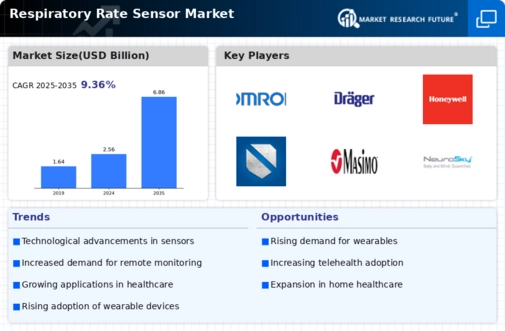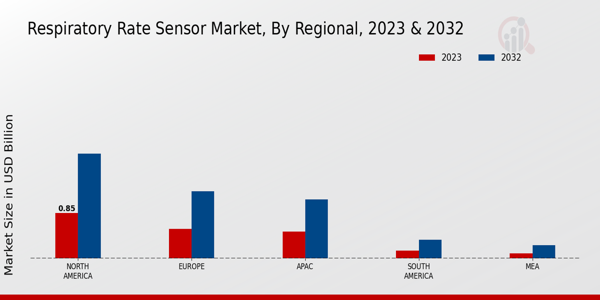Growing Aging Population
The global aging population is a significant driver of the Global Respiratory Rate Sensor Market Industry. As individuals age, they often experience a decline in respiratory function, making them more susceptible to respiratory diseases. According to demographic studies, the proportion of older adults is steadily increasing, leading to a higher demand for healthcare services and monitoring solutions. Respiratory rate sensors play a crucial role in managing the health of elderly patients, allowing for timely interventions. This demographic shift is likely to contribute to the market's expansion, as healthcare systems adapt to meet the needs of an aging population.
Market Growth Projections
The Global Respiratory Rate Sensor Market Industry is projected to experience substantial growth over the next decade. With a market value expected to reach 2.56 USD Billion in 2024 and an anticipated increase to 6.86 USD Billion by 2035, the industry is poised for significant expansion. The compound annual growth rate of 9.37% from 2025 to 2035 indicates a robust demand for respiratory monitoring solutions. This growth is driven by various factors, including technological advancements, rising prevalence of respiratory disorders, and increased focus on remote patient monitoring. The market's trajectory suggests a promising future for stakeholders involved in respiratory rate sensor development and deployment.
Rising Prevalence of Respiratory Disorders
The increasing incidence of respiratory disorders globally is a primary driver for the Global Respiratory Rate Sensor Market Industry. Conditions such as asthma, chronic obstructive pulmonary disease, and sleep apnea are becoming more prevalent, necessitating effective monitoring solutions. For instance, the World Health Organization indicates that respiratory diseases account for a significant portion of global morbidity and mortality. As awareness of these conditions grows, healthcare providers are increasingly adopting respiratory rate sensors to enhance patient management. This trend is expected to contribute to the market's growth, with projections estimating a market value of 2.56 USD Billion in 2024.
Increased Focus on Remote Patient Monitoring
The shift towards remote patient monitoring is reshaping the Global Respiratory Rate Sensor Market Industry. With the rise of telehealth and digital health solutions, healthcare providers are increasingly utilizing respiratory rate sensors to monitor patients outside traditional clinical environments. This approach not only enhances patient engagement but also reduces hospital readmissions. The integration of respiratory sensors into telehealth platforms allows for continuous monitoring, which is particularly beneficial for chronic respiratory patients. As the demand for remote monitoring solutions continues to rise, the market is expected to grow at a compound annual growth rate of 9.37% from 2025 to 2035.
Regulatory Support and Standards Development
Regulatory support and the establishment of standards for respiratory monitoring devices are fostering growth in the Global Respiratory Rate Sensor Market Industry. Governments and health organizations are increasingly recognizing the importance of accurate respiratory monitoring, leading to the development of guidelines and regulations that promote the use of these technologies. For instance, initiatives aimed at improving respiratory health outcomes are encouraging manufacturers to innovate and comply with safety standards. This regulatory environment not only enhances consumer confidence but also stimulates market growth, as stakeholders are more inclined to invest in compliant respiratory rate sensor technologies.
Technological Advancements in Sensor Technology
Technological innovations in sensor technology are propelling the Global Respiratory Rate Sensor Market Industry forward. Advances in miniaturization, accuracy, and connectivity have led to the development of more sophisticated respiratory rate sensors. These devices now offer real-time monitoring and data analytics capabilities, which are crucial for both clinical and home settings. For example, wearable sensors that integrate with mobile applications provide users with immediate feedback on their respiratory health. This trend is likely to attract both healthcare providers and consumers, thereby expanding the market significantly. The anticipated growth trajectory suggests a market size of 6.86 USD Billion by 2035.













